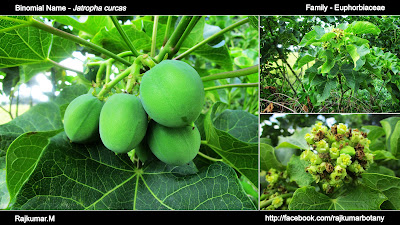Jatropha curcas
Binomial Name - Jatropha curcas
Common Name - Physic Nut
Tamil Name - Kattamanakku ( காட்டாமணக்கு )
Family - Euphorbiaceae
Place - Jawadhu Hills, Tiruvannamalai, TN, India
Date - Sep 2015
Uses
---> The seeds contain about 37% of this non edible oil; it is used in the production of biodiesel.
---> The jatropha oil burns with clear free smoke and flame.
---> It's high saponification the oil is used to make soap in some parts of the world.
---> It is used on the domestic livestock for skin diseases, sore and rheumatism.
---> The juice of the leaf is used for piles as an external application.
---> The roots are believed to act as an antidote for snake bites.
---> A dark blue dye is extracted from the bark of jatropha. This dye is used as a coloring matter for clothes, fishing nets, and lines.
---> Jatropha oil cake is used as organic manure since it is rich in potassium, phosphorous, and nitrogen.
---> Silkworms consume the leaves of the jatropha leaves for their diet.
---> SEEDS : Seeds are used to produce insecticides. Jatropha seed is used as a medicine for constipation. Oils extracted from jatropha plant is used as biofuel. Interest exists in producing animal feed. Sometimes roasted and eaten.
---> OIL : The oil is used to soften the leather Also used for making soap. The oil has been used for illumination, candles, the adulteration of olive oil, and making Turkey red oil.
---> LEAVES : Leaves of jatropha are used as a massage material for strained muscles
It is used as a brewed tea to combat malaria.
The young leaves of jatropha can be safely eaten by steaming them or cooking it.
Powdered jatropha leaves are applied to horses eyes to get rid of the flies since hydrogen cyanide is present in the leaves.
---> Bark of jatropha is used as a fish poison.



.jpg)











.jpg)



No comments: